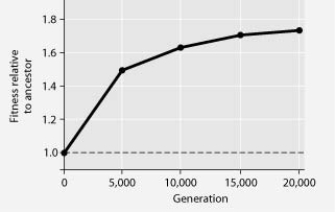Multiple Choice
In this eight-year experiment, 12 populations of E. coli, each begun from a single cell, were grown in low-glucose conditions for 20,000 generations. Each culture was introduced to fresh growth medium every 24 hours. Occasionally, samples were removed from the populations, and their fitness in low-glucose conditions was tested against that of members sampled from the ancestral (common ancestor) E. coli population. 
-E. coli cells typically make most of their ATP by metabolising glucose. Under the conditions of this experiment, E. coli generation times in the experimental lines and low-glucose conditions should ________.
A) be the same as in the typical environment
B) be faster than in the typical environment
C) be slower than in the typical environment
D) increase over time in the experimental cells
Correct Answer:

Verified
Correct Answer:
Verified
Q7: The predatory bacterium Bdellovibrio bacteriophorus drills into
Q13: If all prokaryotes on Earth suddenly vanished,
Q19: Sexual reproduction in eukaryotes increases genetic variation.
Q21: The following table depicts characteristics of five
Q24: In this eight-year experiment, 12 populations of
Q25: The following table depicts characteristics of five
Q28: The pathogenic prokaryotes that cause cholera are
Q30: Nitrogenase, the enzyme that catalyses nitrogen fixation,
Q43: Which of the following traits do archaeans
Q58: Chloramphenicol is an antibiotic that targets prokaryotic